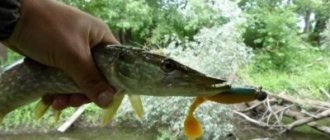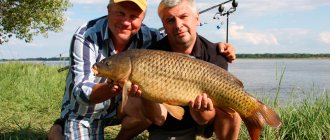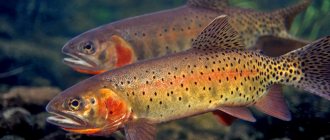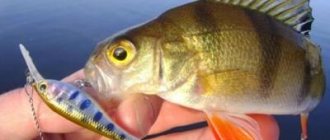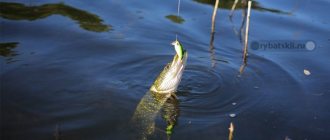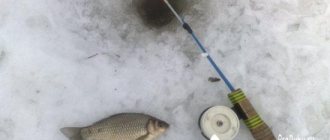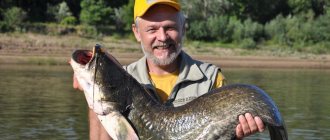We fish from the shore without using a watercraft. Features of catching predatory fish in snags. Recommendations on the choice of baits and the features of their wiring. Evolution of snag.
The predator always gravitates towards the snag. There are ideal conditions for camouflage here, there is always a wide variety of little things, so you can hunt successfully. At the same time, fishermen often bypass such areas, because the chance of breaking off the bait is high, and snags mainly form under steep concave banks, where it is not always convenient to fish with a spinning rod. But it is possible to catch a predator in snags, and the catch may include not only the ubiquitous perch, but also large pike. If the rubble of snags is located at a significant depth, then you can catch pike perch in them, and often trophy ones.
The spring flood strongly erodes the shore, which leads to trees falling into the water. If there is a pronounced current, the fallen trunks will gradually be dragged towards the exit of the pit, where real “windfalls” can form. This way the concentration of fish is higher, but the fishing conditions are extremely difficult, and there is nothing to do on such plantations without a boat. We will consider fishing from the shore as more widespread and widespread.
How does the snag evolve?
It is worth remembering that fishing in snags formed by trees that have fallen this year is fraught with the loss of bait on each cast. And there’s not much fish in this cake yet. A dense network of small branches mercilessly catches any bait, and it is inconvenient for a predator to hunt in such conditions. It’s another matter if the trees have been lying in water for a couple of years. The small branches have long since rotted and fallen off, and only the skeleton of the snag, formed by relatively large branches, remains.
In the presence of a pronounced current, the process of “exposing” the fallen tree occurs much faster. Such a snag is already of some interest to the fisherman, although it is difficult to fish in it. Here it is important to conduct a thorough reconnaissance, calculate the contours of the “skeleton”, and determine the position of the trunk and branches. And, of course, stock up on bait.
Further, over the years, the fallen tree will lose its relatively large branches, and the entire snag will be represented by only a trunk with several large branches. It is also of some interest to fishermen, although there will be fewer predators there than in the location described above.
Pike fishing in snags
Finding snags on an unfamiliar body of water can be difficult . To do this, you can explore the water area on a boat with an echo sounder . But in some cases, snags protrude directly above the surface of the water.
This often happens on reservoirs , when the remains of flooded trees are clearly visible, and in such a situation there is no need to explore the reservoir in search of a promising point.
If you are going to fish in snags, you need to choose the right gear . To prevent the pike from tangling the equipment after biting, it must be quickly moved away from the bottom debris. This will require a powerful rod and thick fishing line. A strong spinning rod is one of the most important conditions for successful fishing among snags. When using braided fishing line with a high breaking load, you can tear the bait out of the hooks, and in this case the losses will be minimal .
Lures for fishing in snags
In most cases, snags are caught with jig baits. They allow you to pinpoint fish an area, do not require space to bury it and include it in the game, and are quite inexpensive. Moreover, jig baits for snags can be mounted in a non-hooking version, which will somewhat reduce the consumption of baits on hooks. In this case, the most effective bait will be a hinged twister mounted on an offset hook. The cargo is a classic Cheburashka.
Lures mounted on a Texas rig work very well in the locations under consideration. Texas installation is based on an offset hook, but instead of the usual “Cheburashka”, it uses a sliding “bullet”. The Carolina rig is somewhat similar to the Texas rig, but the bait has a greater degree of freedom. This may be necessary when catching a passive predator, but in our case, excess freedom will not always be appropriate, as it increases the risk of getting caught.
In addition to jigs, you can also fish snags with wobblers, but there are some peculiarities here.
Firstly, the snag should be relatively “old” and thin. Secondly, the clear space from the branches to the surface of the water should be about a meter, which will allow you to move a surface wobbler over the snags. And as it became clear, you can only fish with surface wobblers with minimal depth, otherwise the wiring of the wobbler will inevitably end up among the branches with the irretrievable loss of the bait.
Lures for catching pike in spring snags
As you already understood, here we will talk about baits that can overcome difficult-to-pass areas. For example, you can take a classic vibrator. This is an excellent tackle for catching pike, but when you encounter the first snag you can say goodbye to it.
Non-snacking oscillator
However, if you have a non-hooking spoon in your arsenal, then the process of catching a predator in a snag will become much more fun and effective. Due to special metal antennae that cover the sting of the hooks, the bait easily passes all obstacles in its path, except for pike, of course.
Spinnerbait
Another quite popular bait for catching predators in grass and snags. Due to its design, it easily passes all the branches and bushes in its path. Quite versatile, it catches both pike perch and pike well. You can count on perch as bycatch if the tackle is not too large.
Jig unhooked
A classic jig in snags is a disaster. However, if you resort to some tricks, you will get a completely working non-snag. Surely you have heard about jig-rig, Carolina or Texas rig? These variations of jig fishing are based on an offset hook, which is hidden in the body of a silicone bait.
However, you should be prepared that the ideal bait that will go everywhere simply does not exist. Therefore, you should not place unnecessary hopes; losses are inevitable in any case.
You can also fish with wobblers, spinners and regular spoons, but remember that one awkward movement can lead to a snag. Try fishing over snags and bushes, this can also bring results.
As for sinkers, you should not give preference to typical Cheburashkas. It is better to put the weight in the shape of a bullet; it will be easier to pass obstacles.
Features of catching a predator in snags
When fishing in snags, the fisherman’s work comes down to targeted catching of local promising places. Sometimes, it’s just a couple of meters of wiring, after which the bait is simply reeled out. When loading a jig bait for fishing in snags, you need to select the load so that it is sufficient to cast to the required distance and ensure the bait plays when falling . It is on the fall that you can get good bites in cramped conditions, so this element cannot be neglected. The load on the bait should be minimal, taking into account the requirements discussed above.
The area adjacent to the rubble is also of interest, so you definitely need to fish it. The trunk of a fallen bank lying across the shore is necessarily fished with a series of parallel casts along this trunk. If there is a branch extending from the trunk, and its position is known, then you can simply jump over it with a jig, increasing the speed of the retrieve and raising the rod. It will look like a very high step.
In conclusion, we note that fishing in snags is carried out in a forced mode. Otherwise, the predator will hide in the support, from where it will be impossible to get it out.
Special place - special catch
Personal best
Is there still a place for the classic donke in modern fishing?
Fishing in snags. Interesting and rewarding!
As you know, predatory fish always gravitate towards all kinds of shelters. It can be bottom debris, thickets of grass and, of course, bottom driftwood. Snag is an excellent shelter for catfish, pike, pike perch and schools of perch. This is a great place for an ambush, as well as good cover from larger predators. And whatever one may say, a snag is a place where the fish are well protected from the fisherman’s baits. Familiar tricks told about snags, which, like Christmas trees, are strewn with all kinds of bait. It’s impossible to even count everything - there simply wasn’t enough breath. Maybe we should just avoid such places?
In no case! Koryazhnik is a very promising spot where there is sure to be fish. It cannot be a priori that no predator lives among the branches. As a rule, several species can coexist in one snag. From one point I was able to catch pike perch and pike perch, or pike perch and pike perch. By the way, the size of the fish is very different. From the same place where I took a 2 kg pike, after a short time I caught zander weighing up to half a kilo. In theory, the pike was supposed to eat such pike perch, which means they couldn’t be around. But they were, and as I understand it, they coexisted peacefully with a larger predator. Although, who knows, it might not be peaceful at all... My friends, who often fish in large bodies of water, are big fans of trophy fishing. And first of all, they try to catch snags. The largest pike perch in their lives were “pulled out” from the dense underwater jungle. It’s interesting how the guys look for the habitats of trophy fish: first they break through the snags for the presence of small fish, and if there are no bites for a long time, this means that the point has been found, and somewhere there, among the branches of once beautiful trees, a monster is hiding. They begin to torture him. Sometimes it works, sometimes it doesn't. The point is that where there are trophy specimens, there are still no smaller predators.
Fishing in snags is quite a difficult and costly fishing, in the sense that the angler can lose a lot of bait. It should be understood that even “ideal” non-hook baits (the tip of the hook is located in the body of the silicone bait) can get caught in the underwater jungle. Most often, this happens if the sting is exposed during the contact of the bait with obstacles, if the jig head gets stuck between the “slingshot”, or if the hook or equipment elements cling to the hooks of old baits that are very tightly embedded in the wood. With this in mind, I prefer to use 0.18mm braid. Such a cord has a colossal margin of safety, and the chances of saving the bait are increased. Fishing in snags is associated with such an unpleasant moment as the line rubbing against the branches. It is possible to combat this problem, but there is no 100% effective way. I just use expensive coated cords. They practically do not wear off when in contact with shells, and even more so with wood!
When fishing in snags, I exclusively use an offset hook. It is, in my opinion, the safest. I know that some people mount baits on a double, pressing the stings to the body. I don’t like this kind of editing - there are a lot of hooks. And not all baits can be used to pull off such a joke. The offset printer protects very well from snags. The main thing is that the sting is hidden in the body of the bait. Precisely in the body? The fact is that on some models of bait there are special grooves so that the sting of the hook “lies” in them. In my experience, this is an unreliable installation; snags occur frequently. The bait simply slides a little along the hook when in contact with the branches of snags, thereby exposing the sting. Therefore, the sting must be hidden in the body of the bait. Many people are afraid of this method of installation because the bait turns out to be unhooked and unhooked. However, when using edible baits, the implementation practically does not suffer.
A little about the gear: for snag fishing you need a very powerful rod. There is no need to be delicate with the dough - let it be overestimated. The spinning rod should be so powerful that you can literally pull the fish out of the snag, especially in the first seconds of the fight, when the predator offers the greatest resistance. The coil size is 3000. If it has a lower gear, that’s generally great. With this type of fishing, speed is preferred over power.
Some advice: if you feel like you’ve caught the bait, don’t try to pull it right away. As soon as you realize that you are caught in a snag, stop the wiring and try to “shoot” the bait. It helps me 80% of the time. If I had pulled, I would probably have only worked on bait. Please do not judge me harshly for the article.
No tail, no scales!
